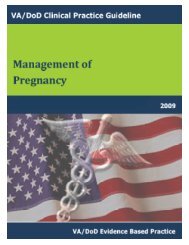DM Full Guideline (2010) - VA/DoD Clinical Practice Guidelines Home
DM Full Guideline (2010) - VA/DoD Clinical Practice Guidelines Home
DM Full Guideline (2010) - VA/DoD Clinical Practice Guidelines Home
You also want an ePaper? Increase the reach of your titles
YUMPU automatically turns print PDFs into web optimized ePapers that Google loves.
Version 4.0<br />
<strong>VA</strong>/<strong>DoD</strong> <strong>Clinical</strong> <strong>Practice</strong> <strong>Guideline</strong><br />
for the Management of Diabetes Mellitus<br />
call, the clinical leaders defined the scope of the guideline and identified a group of clinical experts from the <strong>VA</strong> and<br />
<strong>DoD</strong> to form the Working Group (WG). For this guideline update the WG participants were drawn from the fields of<br />
primary care, endocrinology, internal medicine, nursing and diabetes education who were also from diverse<br />
geographic regions, and both <strong>VA</strong> and <strong>DoD</strong> healthcare systems.<br />
At the start of the update process, the clinical leaders, guideline panel members, outside experts, and experts in the<br />
field of guideline and algorithm development were consulted to determine which aspects of the 2003 guideline<br />
required updating. These consultations resulted in the determinations that guided the update efforts: (1) update any<br />
recommendations from the original guideline likely to be affected by new research findings; (2) provide information<br />
and recommendations on health systems changes relevant to diabetes care; (3) address content areas and models of<br />
treatment for which little data existed during the development of the original guideline; and (4) review the<br />
performance and lessons learned since the implementation of the original guideline.<br />
After orientation to the guideline scope and to goals that had been identified, the WG developed ten (10)<br />
researchable questions within the focus area of the guideline and identified associated key terms. This ensured that<br />
the guideline development work outside of meetings focused on issues that practitioners considered important. This<br />
also produced criteria for the literature search and selection of included studies that formed the body of evidence for<br />
this guideline update.<br />
These literature searches were conducted covering the period from January 2002 through June 2009 and focused on<br />
the topics identified by the research questions. Electronic searches were supplemented by reference lists and<br />
additional citations suggested by experts. The identified and selected studies on those issues were critically<br />
analyzed, and evidence was graded using a standardized format. The evidence rating system for this document is<br />
based on the system used by the U.S. Preventive Services Task Force (USPSTF).<br />
If evidence exists, the discussion following the recommendations for each annotation includes an evidence table<br />
identifying the studies that have been considered, the quality of the evidence, and the rating of the strength of the<br />
recommendation which is presented in brackets following each guideline recommendation [SR] (see Table:<br />
Evidence Rating System).<br />
Evidence Rating System<br />
SR<br />
A<br />
B<br />
C<br />
D<br />
I<br />
A strong recommendation that clinicians provide the intervention to eligible patients.<br />
Good evidence was found that the intervention improves important health outcomes and concludes that<br />
benefits substantially outweigh harm.<br />
A recommendation that clinicians provide (the service) to eligible patients.<br />
At least fair evidence was found that the intervention improves health outcomes and concludes that benefits<br />
outweigh harm.<br />
No recommendation for or against the routine provision of the intervention is made.<br />
At least fair evidence was found that the intervention can improve health outcomes, but concludes that the<br />
balance of benefits and harms is too close to justify a general recommendation.<br />
Recommendation is made against routinely providing the intervention to asymptomatic patients.<br />
At least fair evidence was found that the intervention is ineffective or that harms outweigh benefits.<br />
The conclusion is that the evidence is insufficient to recommend for or against routinely providing the<br />
intervention.<br />
Evidence that the intervention is effective is lacking, of poor quality, or conflicting, and the balance of<br />
benefits and harms cannot be determined.<br />
SR = Strength of recommendation<br />
Where existing literature was ambiguous or conflicting, or where scientific data was lacking on an issue,<br />
recommendations are based on the clinical experience of the Working Group. Although several of the<br />
recommendations in this guideline are based on weak evidence, some of these recommendations are strongly<br />
recommended based on the experience and consensus of the clinical experts and researchers of the Working Group.<br />
Recommendations that are based on consensus of the Working Group include a discussion of the expert opinion on<br />
the given topic. No [SR] is presented for these recommendations. A complete bibliography of the references in this<br />
guideline can be found in Appendix D to the full guideline.<br />
This <strong>Guideline</strong> is the product of many months of diligent effort and consensus building among knowledgeable<br />
individuals from the <strong>VA</strong>, <strong>DoD</strong>, and a guideline facilitator from the private sector. An experienced moderator<br />
facilitated the multidisciplinary Working Group. The draft document was discussed in two face-to-face group<br />
meetings. The content and validity of each section was thoroughly reviewed in a series of conference calls. The<br />
Introduction Page 4
















